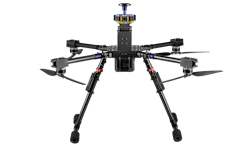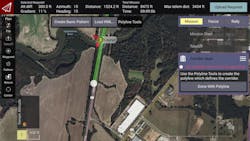Survey Drone Flies in Windy Conditions
Check out our AUVSI Xponential 2023 coverage.
Wispr Systems' John McArthur, VP of Sales & Marketing, talks about the company's Ranger Pro 1100 drone (see video above). The Ranger Pro 1100 is designed to fly in winds up to 50 mph (Fig. 1). It's primarily used in mapping and inspection applications that demand stability and high-resolution camera support.
The Ranger Pro 1100 has its own omnidirectional, LiDAR-based collision avoidance system, which is critical for many of the inspection applications where the drone needs to fly close to other obstacles. The sensors operate in day and night conditions.
Featuring RTK GNSS navigation support, the drone can fly for about 20 minutes with a full payload and almost 40 minutes without. The system's frame is made from carbon fiber and aluminum. It has aircraft-grade electromagnetic shielding to protect against EMI, as it may be used near power lines. The whole system folds up into a compact form for easy movement and storage.
The Wispr System software incorporates fail-safe operation. If an emergency occurs, the drone can return to the launch point and land automatically. The company also provides its own ground control system and software (Fig. 2).
The mission-planning software supports features like terrain following as well as surveying and mapping. The company works with a number of partners to provide application-specific support.
The Ranger Pro 1100 in Action
About the Author
William G. Wong
Senior Content Director - Electronic Design and Microwaves & RF
I am Editor of Electronic Design focusing on embedded, software, and systems. As Senior Content Director, I also manage Microwaves & RF and I work with a great team of editors to provide engineers, programmers, developers and technical managers with interesting and useful articles and videos on a regular basis. Check out our free newsletters to see the latest content.
You can send press releases for new products for possible coverage on the website. I am also interested in receiving contributed articles for publishing on our website. Use our template and send to me along with a signed release form.
Check out my blog, AltEmbedded on Electronic Design, as well as his latest articles on this site that are listed below.
You can visit my social media via these links:
- AltEmbedded on Electronic Design
- Bill Wong on Facebook
- @AltEmbedded on Twitter
- Bill Wong on LinkedIn
I earned a Bachelor of Electrical Engineering at the Georgia Institute of Technology and a Masters in Computer Science from Rutgers University. I still do a bit of programming using everything from C and C++ to Rust and Ada/SPARK. I do a bit of PHP programming for Drupal websites. I have posted a few Drupal modules.
I still get a hand on software and electronic hardware. Some of this can be found on our Kit Close-Up video series. You can also see me on many of our TechXchange Talk videos. I am interested in a range of projects from robotics to artificial intelligence.


